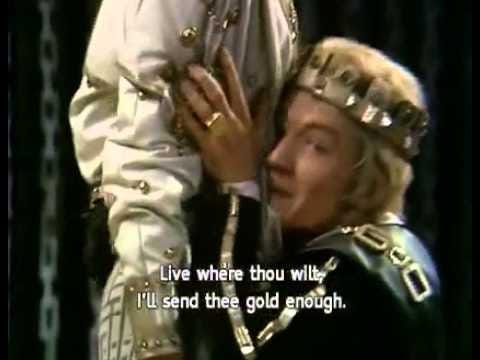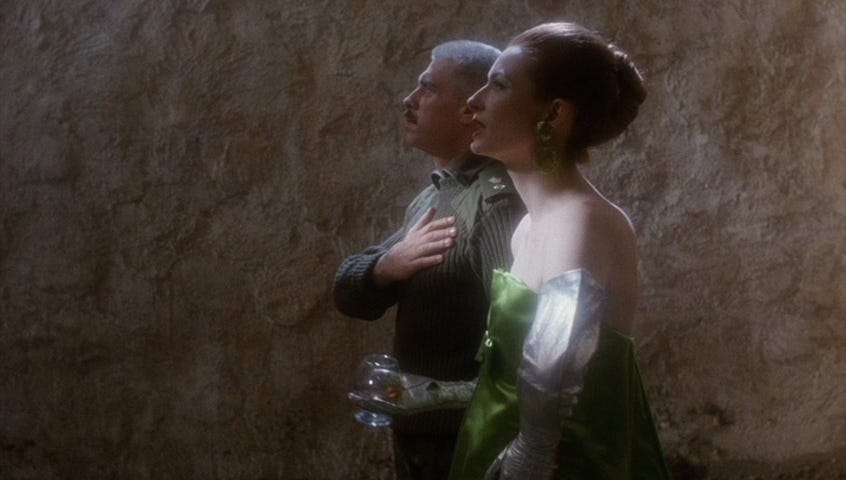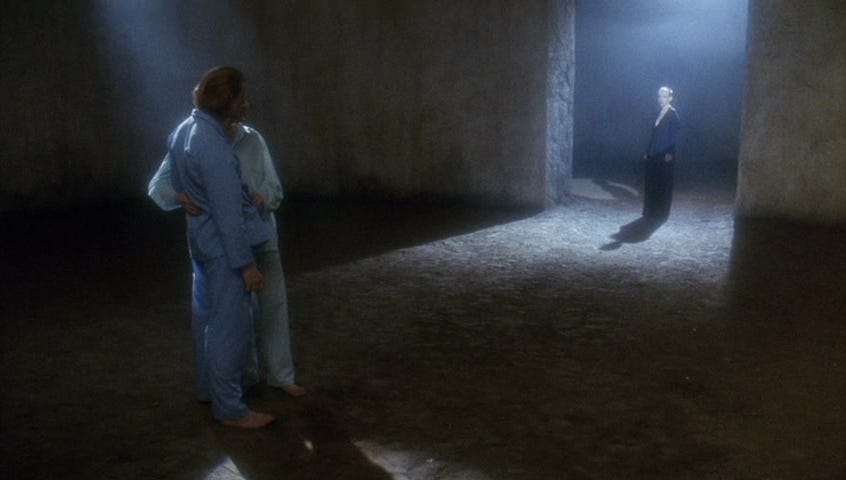Edward II: No love song finer
Derek Jarman's adaptation of the Renaissance play is a radical work of queer art.
In 1970, Sir Ian McKellen played the titular king in a touring production of Christopher Marlowe’s Edward II. Rarely performed, the play follows a clash between Edward and his court over his devotion to Piers Gaveston, his favorite, leading to Edward’s downfall. The production was broadcast on the BBC, and apparently featured the first televised kiss between two men. When asked years later if this caused controversy, McKellen responded that “it was a play by Christopher Marlowe, a contemporary of Shakespeare’s. It was the Prospect Theatre Company, highly respectable. It might’ve been run by a gaggle of gays, but that wasn’t the point. We weren’t gay sweatshop, we were mainstream devotees of classical theatre, and that’s how the play was received and why it was put on television.”
McKellen did point out, though, that the partial decriminalization of homosexuality that was put in place in England in 1967 was not in effect in Scotland. In their Scottish tour stops, then, they were arguably breaking the law on stage. As a “respectable” company presenting a “classical” play, the company of Edward II achieved the subversive and legally contentious act of performing a gay love story for a wide audience.
In the following 20 years, queer life in the U.K. experienced seismic shifts—most notably, increases in public activism and the mainstream emergence of gay rights as a political goal, the massive public health crisis of AIDS, and the implementation of Section 28 in 1988, which outlawed the “promotion” of homosexuality by government officials and educators. It was in this charged political climate that filmmaker Derek Jarman crafted his own version of Edward II, with this to say: “How to make a film of a gay love affair and get it commissioned. Find an old dusty play and violate it.”
Respectability and tradition enabled the Prospect Theatre Company to stage Edward II with explicit acknowledgment of homosexuality, but respectability and tradition were antithetical to Jarman’s artistic project—Edward II had the name recognition and cultural prominence for him to fund the film, but he aimed to “violate” the text by thrusting it into the present and infusing it with a radical queer sensibility.
Jarman, who directed Edward II three years before dying of AIDS-related complications, was a vanguard of queer art in the 20th century, a writer, artist, and filmmaker whose activism was central to his work. In his films, both narrative and non-narrative, he explored politics, homoeroticism, gender transgression, the natural world, and history with a postmodern sensibility and a collaborative ethos. History was particularly vital to his narrative films, most of which were either formally experimental biopics or inventive adaptations of literary classics.
In a Film Comment profile of Jarman, Harlan Kennedy noted that in these films, “modern sensibility is used to reflect and refract the past—to offer reversals, multiplications, dazzlements—and the invocations here are literary as much as painterly.” This style manifests both in constant anachronisms—for instance, the appearance of digital calculators and electric lighting in Caravaggio, or the sudden appearance of Elisabeth Welch in The Tempest to sing “Stormy Weather.” Instead of giving the illusion of immersion in a bygone world, à la Merchant Ivory, Jarman’s films hold the viewer at a distance and encourage them to consider intersections between the past and the present.
The physical environment of Edward II is spartan and foreboding. The entire film is set in a labyrinthine stone structure with high walls and dirt floors. Sounds echo, and light is heavily filtered. Within this dark, insular world, Jarman stages a prolonged battle between conservative nobles and a queer king.
At the outset of the film, Edward (Steve Waddington, boyish) summons his banished favorite Gaveston (Andrew Tiernan, feral) back to court. When Gaveston first appears, he reads the letter from his lover, while in the background of the shot two sailors have sex. Jarman immediately sets up his audience for a film saturated with gay eroticism, a take on a literary classic through a queer gaze. The film is suffused with the aesthetics of gay male sexuality—when Gaveston and Edward reunite, Edward views a muscled performer, in gold briefs and a matching crown, flex while handling a boa constrictor; in another scene they watch two male dancers perform an angular, athletic duet that ends in a kiss. Edward and Gaveston themselves are openly and physically intimate with one another, typically wearing chic, sometimes matching clothes or in states of undress. With Gaveston back at his side, Edward presides over a manifestly gay culture in his court. Antagonizing elements are disposed of—a priest who bemoaned Gaveston’s return is imprisoned at Gaveston’s request, and attacked by him and a leather-clad posse.
The lords and earls that surround Edward are displeased, particularly the ambitious Mortimer (Nigel Terry), who whispers that “this ground, which is corrupted with their steps, shall be their timeless sepulcher, or mine.” Edward’s wife Isabella (Tilda Swinton), too, is beleaguered by her husband’s love for Gaveston—in bed, she leans down to kiss Edward repeatedly, to which he recoils each time, until she lets herself fall onto the bed and he rises to slam his head into the wall.
Mortimer engineers a plot to exile Gaveston. He calls a meeting with the nobility, and decides to force Edward to banish him; if not, they’ll depose him by force. Jarman frames the meeting of lords and earls around a long conference table, with the nobles played by an ensemble of middle-aged white men and women in drab suits. The organized resistance to Edward’s reign is conservative, businesslike, and administrative.
Mortimer and Isabella represent conventional, unsettling ideas of masculinity and femininity. Mortimer is framed as a macho, conservative symbol of patriarchy throughout the film and as a hypocrite—later, while being sexually dominated by two women, he exclaims that “This Edward is the ruin of the realm.” Isabella wields femininity like armor. She wears impeccably applied makeup, immobile hairstyles, and lavish couture (the costumes were designed by frequent Jarman collaborator Sandy Powell). Swinton’s performance works in tandem with her character’s hermetically sealed glamour: her Isabella is impassive and cold, with a flat expression revealing few hints of an inner life. When Mortimer and Isabella begin an affair and consolidate power to resist Edward’s reign, their partnership is one of punishing heterosexuality in contrast to Edward and Gaveston’s hedonistic homosexuality.
Their first move together is to summon Gaveston back to placate the bereft Edward, then murder him. Edward and Gaveston’s initial joy at their reunion is tempered by the hostile response to Gaveston’s return—he is snubbed at a party, and when he accosts the nobles in attendance, Mortimer stabs him (though not fatally). This act of violence acts as a catalyst for an all-out battle between the two factions; Mortimer and Isabella kick their plan to take over the crown into high gear, and Edward brings Gaveston’s friend Spencer into his inner circle to resist.
It’s here where Jarman makes his most specific ties to contemporary political struggle. A massive police force led by Mortimer closes in on Gaveston, and one kills him at Mortimer’s command by throttling a baton against his neck. Edward, galvanized, leads a massive group of protestors to fight back. These were actual members of OutRage!, a British gay rights movement, and in the film they carry protest signs including “GAY DESIRE IS NOT A CRIME” and “STOP VIOLENCE AGAINST LESBIANS AND GAY MEN,” and chant “Stop the murders! Stop the lies! Queer love will never die!” He stages a violent struggle—Edward and Spencer kill a cop by stabbing him in the groin, the police shoot protestors against a wall, Mortimer breaks Spencer’s neck and calls his corpse “girlboy,” Isabella kills Edward’s allegiance-shifting brother by sinking her teeth into his neck and draining the blood. In Jarman’s vision, a 14th-century struggle for the throne becomes an urgent battle for queer equality in an increasingly fascist society.
Marlowe’s story ends with Mortimer and Isabella (alongside Edward and Isabella’s young son, Edward III) imprisoning Edward and taking the throne, then surreptitiously ordering Edward executed. The executioner pursues an unorthodox method—he sodomizes him with a hot poker, burning him from the inside out. Edward and Isabella’s son, Edward III, learns of the assassination, and orders Mortimer executed and Isabella imprisoned, then becomes sole ruler. In Marlowe’s conception, Edward’s susceptibility to misplaced influence and Mortimer and Isabella’s hubris lead to all of their eventual downfalls, clearing the way for Edward III to take the throne and restore order.
Jarman thinks differently. Mortimer and Isabella do retake the throne, imprison Edward, and order his execution. Edward dreams about the execution-by-hot poker, but the executioner has a change of heart and tosses the poker aside, enveloping Edward in a passionate kiss. Edward III (child actor Jody Graber) does depose Mortimer and Isabella. In a striking scene, both are caged and covered in ashes, while he dances on top of the cage to the “Dance of the Sugar Plum Fairy,” wearing his mother’s lipstick, earrings, and heels. Jarman’s ultimate, radical vision is to imagine a queer victory over fascism and state violence; a kiss between men replaces an execution, and a gender-expansive child represents a future beyond patriarchy and heterosexism.
Yet in key moments, the film also takes on the form of an elegy. The most memorable, emotive moment of the film for me occurs before Gaveston is to be banished. Edward and Gaveston, both wearing blue pajamas, come together in a cavernous room to say their goodbyes. “Was there ever such a king as overruled as I?”, says Edward. Waddington’s says the line not indignantly or despairingly, but with a tender sadness. In the background, the voice of Annie Lennox singing Cole Porter’s “Every Time We Say Goodbye” (“every time we say goodbye / I die a little”) is heard; Edward and Gaveston begin to dance together, and Jarman reveals Lennox standing in the doorway, looking on.1 She sings the entirety of the song, and Jarman cuts between Lennox and Edward and Gaveston dancing in the middle of a spotlight—one shot is high-angle, making them tiny in the vast room. At the scene’s conclusion, they share a soft, deep kiss, then, leaning on each other, look on at Lennox as she finishes the song.
In a Washington Post review, Hal Hinson describes the moment as “Marlowe meets MTV”—in keeping with the film’s kaleidoscopic postmodernism, a hallmark of contemporary culture enters the realm of the past. If the music video-esque scene is in keeping with the film’s aesthetic and narrative project, then it’s also a major tonal departure. The open-hearted emotionality, and the pain of loss, expressed by Lennox, Waddington, and Tiernan in this scene has an earnestness and vulnerability generally uncharacteristic of the film, until the closing shot. Here, the camera pans across a still tableau of OutRage! protestors, with Waddington speaking in voiceover before the film fades to black:
But what are kings when regiment is gone
but perfect shadows in a sunshine day?
I know not. But of this I am assured:
that death ends all and I can die but once.
Come death, and with thy fingers close my eyes.
Or if I live, let me forget myself.
Here, Jarman combines some of Marlowe’s text with a quotation from Shakespeare’s Henry IV Part II (“a man can die but once.”) The stillness of the protestors, and the text’s meditation on mortality, reflects both the effects of the AIDS pandemic in the queer community and Jarman’s own illness. The emotional weight given to an unavoidable parting between lovers, and the acceptance of death expressed in the final frame, are poignant moments that represent both the inseparability of queer life and the AIDS crisis in 1991, and Jarman’s reckoning with his own mortality.
What I love about Edward II, ultimately, is that Jarman uses Christopher Marlowe’s “dusty” play as a palimpsest, taking the play’s verse dialogue and royal intrigue as his base, and adding layers of homoeroticism, political critique, aesthetic extravagance, and above all queer activism. What results is a film that doesn’t pay homage to the past, nor accurately represent the present, but uses a canonized text to form a blazingly contemporary piece of art, one which still feels uncommonly radical decades later.
Up next: An essay on Todd Haynes’ Far From Heaven.
In 1990, Annie Lennox had recorded a music video of “Every Time We Say Goodbye” for “Red Hot + Blue,” a compilation album of Porter songs which benefitted AIDS organizations. Jarman intended to direct, but wasn’t well enough to do so, and was replaced by Ed Lachman. In the poignant video, home videos from Jarman’s childhood are projected across Lennox’s face.






